The New Zealand dollar is the official currency of New Zealand and other Oceanian territories such as the Cook Islands, Niue, Tokelau and the Pitcairn Islands.
Its ISO 4217 code is NZD and its symbol is NZ$, although within the country the symbol $ is usually used, always written just before the amount. The New Zealand dollar is divided into 100 cents.
As of August 16, 2023, the currency equivalence (not the “paper” banknote) of the New Zealand dollar against the euro is:
- 1 euro = 1.83 New Zealand dollars.
- 1 New Zealand dollar = 0.55 euros.
History of the New Zealand dollar
The New Zealand dollar was created in 1967 to replace the New Zealand pound, which had been the official currency of the country since its decoupling from the pound sterling in 1933. The main reason for creating the NZ$ was to introduce a system Fractional decimal type, less complex than the previous one.
As a curiosity, many names were proposed to denominate the new New Zealand currency. Among others fern, kiwi and zeal. In the end, even at the risk of confusion with the US dollar, the current dollar denomination was chosen.
The Central Bank of New Zealand (Reserve Bank of New Zealand), based in Wellington, is the institution responsible for issuing New Zealand dollar notes and coins.
New Zealand dollar coins
The New Zealand dollar is divided into 100 cents. The currently valid series of coins consists of the following dollar and cent coin denominations:
- Penny coins: 10c, 20c and 50c.
- NZ dollar coins: $1 and $2.

On the obverse of all New Zealand coins appears the image of Queen Elizabeth II of England (do not forget that New Zealand belongs to the Commonwealth). The reverses present different motifs of the country’s culture and natural heritage.
The lowest value coin is the 10c, recognizable for being the smallest in the series and for its characteristic tan color. On the reverse is a koruru, the traditional carved wooden Maori mask. The 20c and 50c coins are cupronickel and silver in color. There are two different designs for each of them.
The $1 and $2 coins were introduced in 1991 to replace notes of the same value. They are golden in color and made of an aluminum and bronze alloy. Two iconic New Zealand wildlife birds decorate the reverses: the kiwi on the $1 coin and the kotuku on the $2 coin.
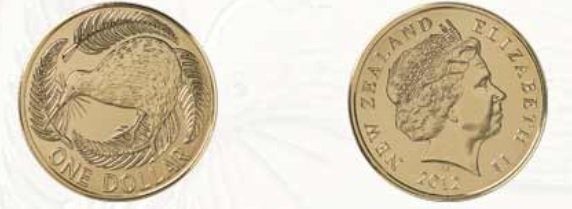
New Zealand dollar banknotes
The current series of notes issued by the Reserve Bank of New Zealand is the seventh in the history of this coin and was issued in October 2015.
The banknotes of the previous series are still valid, although they are gradually being withdrawn from circulation, so they are increasingly scarce. The banknotes of the last series are very similar to those of the previous series, although clearer and sharper.
There are currently five New Zealand dollar notes in circulation with the following denominations: $5, $10, $20, $50 and $100.

Its obverses depict different prominent figures from the country’s history, while the reverses are dedicated to New Zealand’s rich cultural and natural heritage. And all these banknotes incorporate texts in Maori:
Aotearoa, which means New Zealand in Maori. Te Pūtea Matua, which is the Maori translation of the Central Bank of NZ. And Maori names for the country’s exotic bird species: hoiho, whio, kārearea, kōkako and mohua.
New Zealand five dollar banknote ($5)
The $5 banknote is orange in color and the character that appears on its obverse is Sir Edmund Hillary (1919 – 2008), the first man to reach the top of Everest, in 1953. In the background is an image of Mount Cook (Aoraki in Maori language), the highest peak in New Zealand.
The reverse features a yellow-eyed or yellow-eyed penguin, one of two species in the genus Megadyptes, which inhabit south-eastern New Zealand. This design was awarded with the international award of “best banknote of the year 2015”.
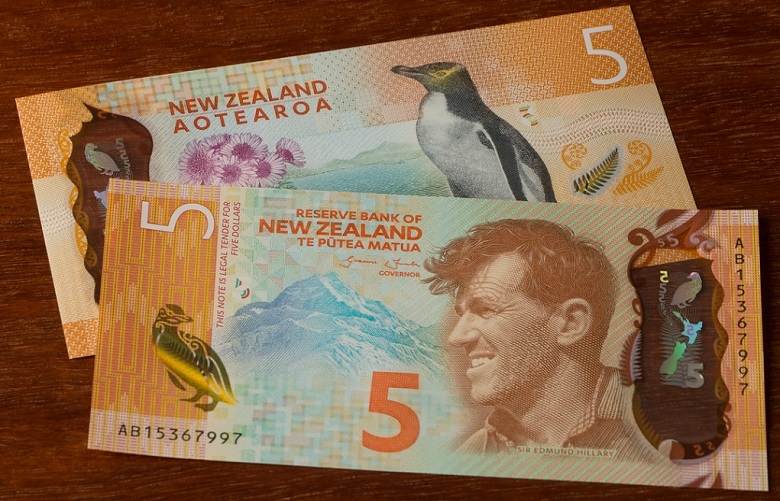
Its value at the current exchange rate in France, August 2023, is about 2.49 euros.
New Zealand ten dollar note ($10)
Blue in color, the obverse of the $10 banknote displays the image of Kate Sheppard (1848 – 1934), a historical figure of feminism in the country and the suffrage movement in the country. In 1893 she made New Zealand the first country in the world where men and women could vote. The reverse features a whio, the famous New Zealand blue duck.

Its value at the current exchange rate in France, August 2023, is about 4.98 euros.
Twenty New Zealand Dollar banknote ($20)
As with the coins, the green $20 banknote features Queen Elizabeth II of England alongside an image of the official New Zealand Parliament Buildings. The reverse shows a kārearea, which is the New Zealand falcon (Falco novaeseelandiae) and Mount Tapuaenuku, the island’s highest peak at 2,885 metres.
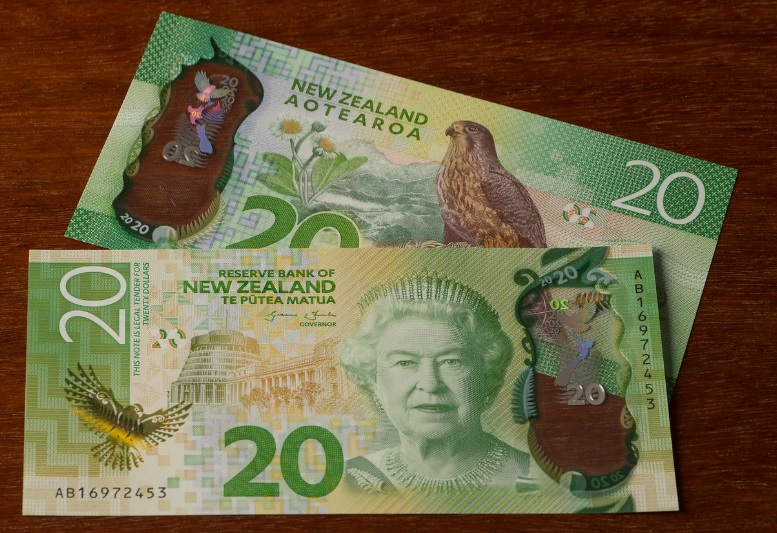
The equivalent value of this banknote at the current exchange rate in France, August 2023, is about 9.96 euros.
New Zealand fifty dollar banknote ($50)
The purple $50 note pays tribute to Sir Apirana Ngata (1874 – 1950), a lawyer (the first Maori to graduate from a university in the country) and politician considered the most prominent member of Parliament.
The images on the back offer a small selection of the country’s fauna and flora, through different species such as the Kōkako (Callaeas wilsoni) or a bluish mushroom native to the country.
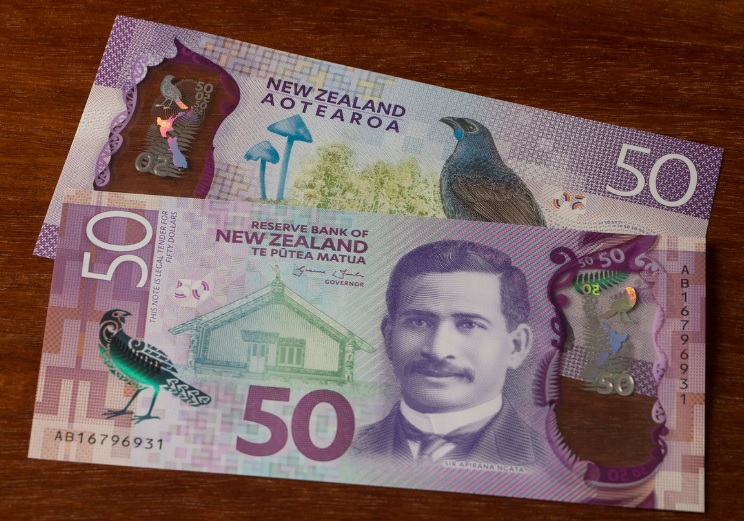
The equivalent value of this banknote at the current exchange rate in France, August 2023, is about 24.90 euros.
New Zealand one hundred dollar banknote ($100)
The highest value banknote in New Zealand is red. The effigy of Lord Rutherford of Nelson (1871 – 1937), Nobel Prize in Chemistry in 1908 for his studies on the atom, is the one shown on the obverse of the $100 banknote , along with his medal. The reverse shows exotic species such as the Mōhua, a species of canary (Mohoua ochrocephala) and a “zebra” moth (Declana egregia).
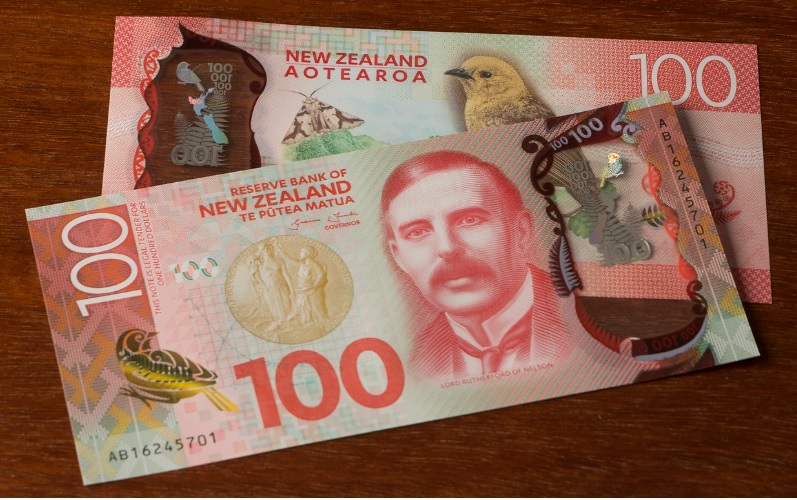
The equivalent value of this banknote at the current exchange rate in France, August 2023, is about 49.80 euros.
Euro to New Zealand dollar exchange rate
The exchange rate of the euro against the New Zealand dollar is usually quite stable, although subject to occasional fluctuations. If you search in Google for “euro to New Zealand dollar rate” you will find dozens of websites (“currency converters”) that offer a “rate” of the day.
You will also see this graph with the prices of that pair of currencies from Google Finance. Something like this (August 16, 2023):
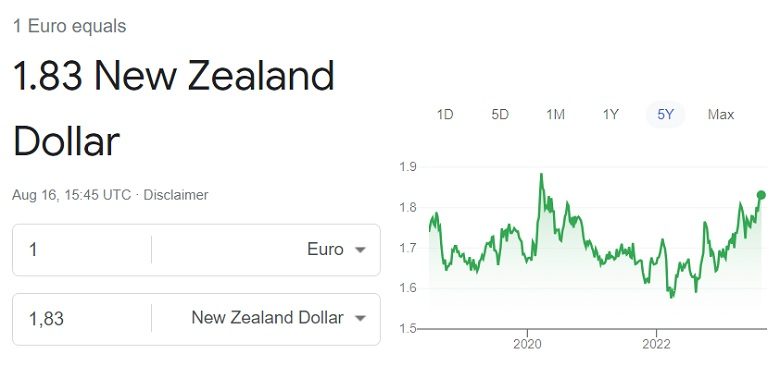
As you can see, the exchange rate in recent years has oscillated between NZD 1.44 and NZD 1.81 per euro, but keep in mind that this graph represents the value of the NZ dollar “currency” against the euro, and not the of real currency, which is lower.
In fact, in currency suppliers in France you can buy New Zealand dollars today at an exchange rate of around 1.68 NZD for each euro in Comparer Devise or 1.24 in French airports (Global Exchange rate today). Nothing to do with the euro to New Zealand dollar currency exchange.
So, when you see these values in Google and other currency converters with your mobile, you should keep the following in mind:
-It is an unofficial rate, and therefore unreliable. In other words, if you click on the “Disclaimer” link, you get this warning from Google Finance: “Google cannot guarantee the accuracy of the exchange rates displayed. Please confirm current rates before making a transaction that may be affected by changes in exchange rates.”
-These rates that you see are usually wholesale prices of the New Zealand dollar currency against the Euro currency (currency and banknotes of the same currency are not exactly the same thing).
-This rate can only be held by banks among themselves, that is, it is impossible to obtain it as an individual.
If you need New Zealand dollars in banknotes you will have to go through the banknote retail market (bank or currency supplier). This means that the dollars have had to be “transported” by someone for you to enjoy them (or bought from travelers from New Zealand passing through France previously).
In addition to the risk of depreciation that owning NZ dollars (or any other currency) implies, moving banknotes from one place to another has logistical costs that will make their sale price more expensive (the exchange rate that will be applied by whoever sells them to you). ).
The New Zealand dollar is a difficult currency to obtain in our country, which is why its price is usually more expensive in France than in New Zealand. If you decide to buy New Zealand dollars in France, it is good to anticipate the purchase and order them online to obtain a better price.
Where to exchange New Zealand dollars
Buy NZ dollars in France
The three most popular places to exchange New Zealand dollars in France are banks, currency suppliers (bureaux de change) and the main airports (exchange service operated by expensive currency suppliers such as Global Exchange).
Of them, the least recommended place to buy is the airport. It is also not advisable to change in banks and currency suppliers that charge you a commission in addition to an “exchange margin” (difference between the price for which you paid the currency and the price for which it is sold to you).
The best option is to opt for cheap currency suppliers that do not charge you a commission. These currency suppliers collaborate with Comparer Devise and compete every day with each other to give you the best exchange for your New Zealand dollars.
Buy NZ dollars in New Zealand
If you decide to exchange euros for dollars once at your destination, you have several options:

- Currency exchange at Wellington International Airport or Auckland Airport. The service is operated by the British Travelex, known for its very high exchange rates. The only advantage of paying expensive prices at the airport would be the security it offers (but New Zealand is a safe country on its streets) and/or the convenience (needing dollars for first expenses in the country if you arrive at ungodly hours). That is why the amounts that are exchanged at the airport are normally quite low (if they nail it to me, at least it is over a small amount).
- Travelex New Zealand. The drawback is that it is a service designed for New Zealanders leaving the country and not for those who enter. In fact, they do not publish purchase rates for the euro on their website. Only for the sale of foreign currency for its residents.
Euro to New Zealand dollar rate today
To find out the euro to dollar exchange rate, the best thing you can do is use our currency comparator.
- Change euros to New Zealand dollars (EUR-NZD)
- Change New Zealand dollars to euros (NZD-EUR)
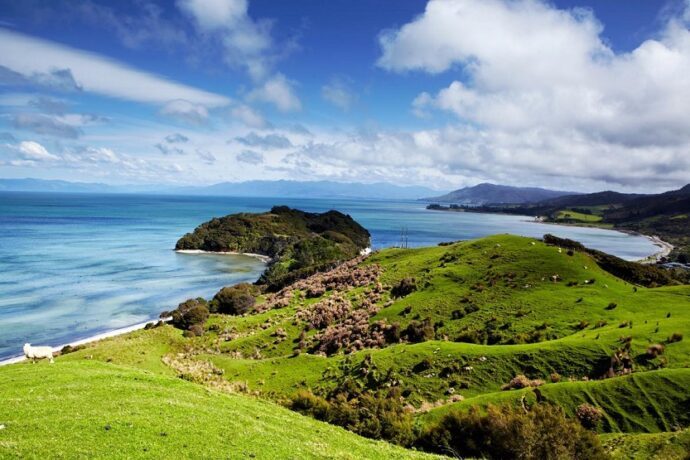
Sin comentarios